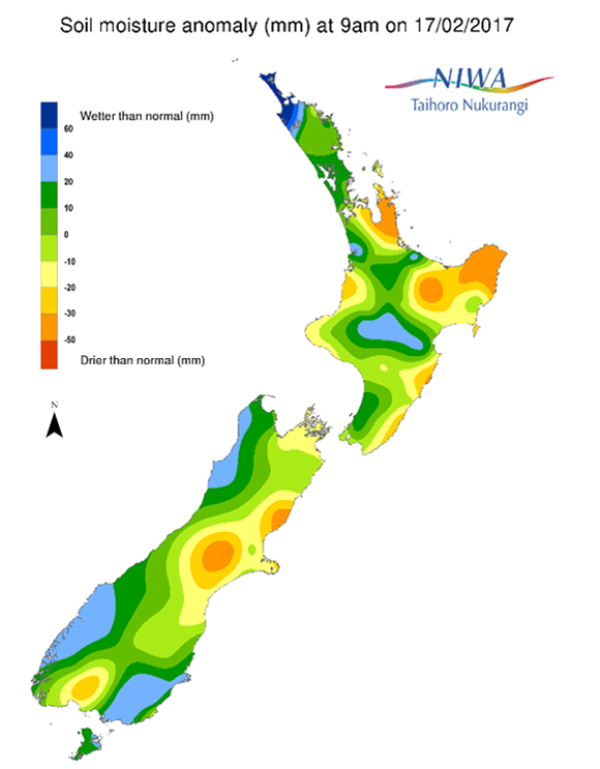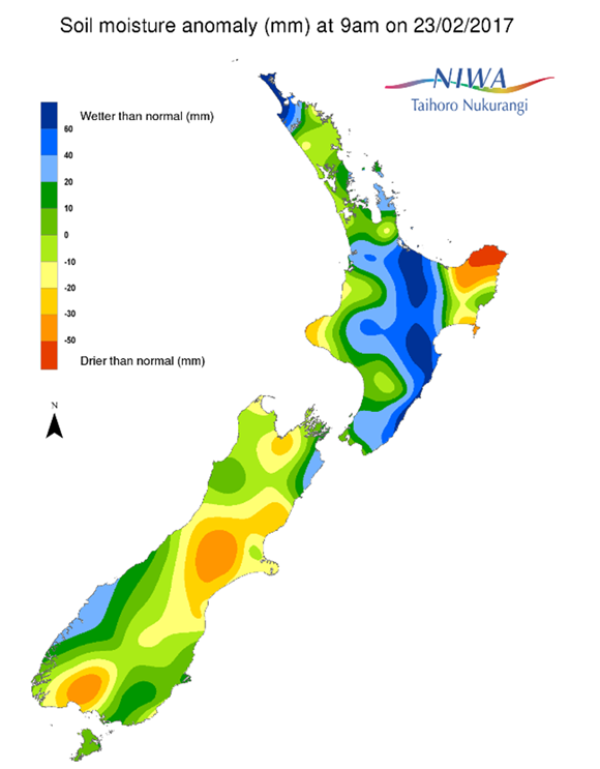A weekly update describing soil moisture across the country to help assess whether severely to extremely dry conditions are occurring or imminent.
Regions experiencing these soil moisture deficits are deemed “hotspots”.Persistent hotspot regions have the potential to develop into drought.
Facts: soil moisture
Across the North Island, soil moisture levels have generally increased during the past week primarily due to heavy rain that occurred late last week and the weekend. This is especially true from the western Bay of Plenty to Hawke’s Bay and Wairarapa, as these areas have seen the most substantial soil moisture increases. In fact, the previous hotspot in coastal Wairarapa has dissipated due to the heavy rain last week. Smaller but still significant increases also occurred in the Coromandel Peninsula. Meanwhile, the most substantial soil moisture decreases were observed in East Cape and Opotiki District, with smaller decreases also occurring in Taranaki and southern Northland. The driest soils across the North Island compared to normal for this time of the year are found in East Cape and Opotiki District, while the wettest soils for this time of the year are found in the Far North as well as from western Bay of Plenty to Hawke’s Bay and coastal Wairarapa.
Hotspots remain in place in East Cape, the Opotiki District, as well as on the Mahia Peninsula. In these areas soils continue to be severely to extremely drier than normal for this time of year.
Across the South Island, soil moisture levels have generally decreased slightly during the past week. This was most evident across central Canterbury, the northern West Coast as well as in Tasman. Meanwhile, moderate soil moisture increases were observed in Marlborough and Kaikoura District, with slight improvements in Hurunui District as well. The driest soils across the South Island compared to normal for this time of the year are found in the Selwyn and Ashburton Districts as well as in southwestern Southland, while the wettest soils for this time of the year are found in coastal Marlborough and northern Fiordland.
The hotspot located in Selwyn and Ashburton Districts has increased in size a bit during the past week, while the previous hotspot in coastal Hurunui District has weakened enough to no longer qualify as a hotspot, although soils remain drier than normal there.
Outlook and soil moisture
For the North Island, predominate high pressure during the next week will likely lead to only minimal rainfall for most locations. Isolated showers will be possible along the eastern coast and in Northland on Friday (24th February), but any rainfall will be 5 mm or less. After nearly completely dry weather over the weekend, isolated showers will return on Monday, but amounts will again be meagre. There is the possibility for a few locally heavy showers in the central North Island on Tuesday (28th February), but amounts will likely remain under 15 mm. For the next week as a whole, most North Island locations will only see rainfall totals of 5-15 mm, but a few places in southern and western areas may not see any precipitation at all.
With minimal rainfall expected across the entire North Island during the next week, soil moisture levels are expected to decrease nearly everywhere. This will cause the hotspots in Opotiki District, East Cape, and the Mahia Peninsula to strengthen, with the possibility for additional hotspots to form in central and southern Gisborne. A new hotspot may also form in western Taranaki during the next week.
For the South Island, rainfall amounts are also expected to be meagre during the next week. A weak front will bring a few showers to Southland and Otago on Saturday (25th February), but generally amounts will be less than 10 mm. A few more millimetres may fall across Canterbury on Sunday. However, high pressure is expected to bring nearly completely dry weather to the South Island for much of next week. Rainfall totals across the South Island will be minimal during the next week, with many locations expected to receive less than 5 mm. Only a few locations in eastern areas may receive as much as 10 mm.
Just like the North Island, minimal rainfall during the next week will likely cause soil moisture levels to decrease almost everywhere in the South Island. This will allow the hotspot in Ashburton and Selwyn Districts to strengthen and also to increase in size across central Canterbury. The previous hotspot in Hurunui District will likely return as well. In addition, new hotspots may form in Nelson and southwestern Southland during the next week.
Background
Hotspot Watch: a weekly advisory service for New Zealand media. It provides soil moisture and precipitation measurements around the country to help assess whether extremely dry conditions are imminent.
Soil moisture deficit: the amount of water needed to bring the soil moisture content back to field capacity, which is the maximum amount of water the soil can hold.
Soil moisture anomaly: the difference between the historical normal soil moisture deficit (or surplus) for a given time of year and actual soil moisture deficits.
Definitions: “Extremely” and “severely” dry soils are based on a combination of the current soil moisture status and the difference from normal soil moisture (see soil moisture maps)


